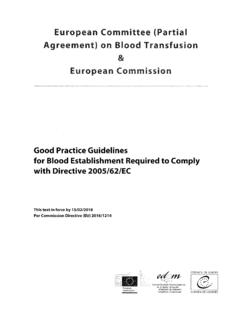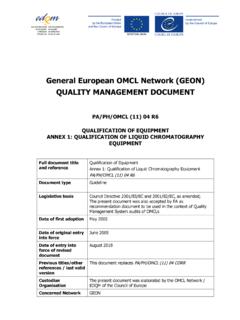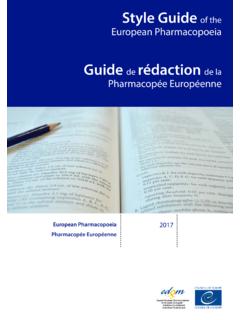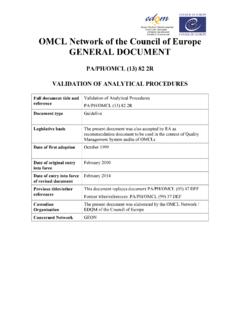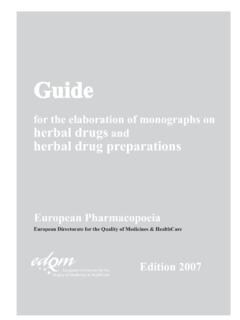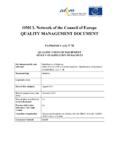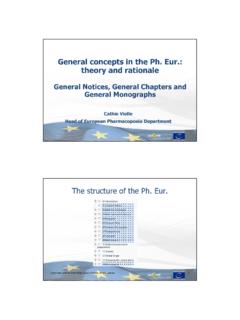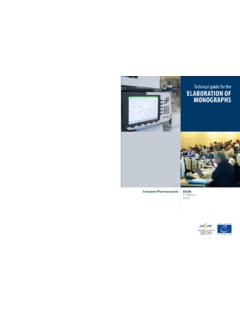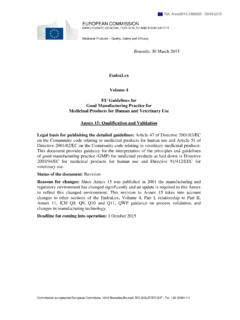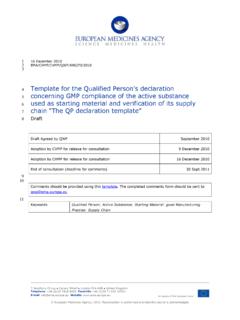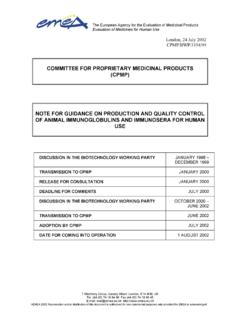Transcription of RESOLUTION AP-CSP (07) 1 Certification of suitability to ...
1 COUNCIL OF EUROPE. PUBLIC HEALTH COMMITTEE. (Partial Agreement). _____. RESOLUTION AP-CSP (07) 1. (adopted by the Public Health Committee (Partial Agreement) (CD-P-SP). on 21/02/2007). Certification of suitability to the monographs of the european pharmacopoeia (revised version). The Public Health Committee (Partial Agreement) (CD-P-SP) consisting, for the purposes of the Convention on the Elaboration of a european pharmacopoeia , of delegations appointed by the Parties to the said Convention, namely the delegations of Austria, Belgium, Bosnia and Herzegovina, Bulgaria, Croatia, Cyprus, the Czech Republic, Denmark, Estonia, Finland, the Former Yugoslav Republic of Macedonia , France, Germany, Greece, Hungary, Iceland, Ireland, Italy, Latvia, Lithuania, Luxembourg, Malta, Montenegro, the Netherlands, Norway, Poland, Portugal, Romania, Serbia, Slovak Republic, Slovenia, Spain, Sweden, Switzerland, Turkey, United Kingdom and the european Union, Considering the implementation of the Procedure for the Certification of suitability of monographs of the european pharmacopoeia adopted on 1 July 1993 by the Public Health Committee (Partial Agreement) (CD-P-SP) in its resolutions AP-CSP (93) 5 and revised on.
2 - 4 October 1996 RESOLUTION AP-CSP (96) 5, - 8 May 1998 RESOLUTION AP-CSP (98) 2, - 22 December 1999 RESOLUTION AP-CSP (99) 4, Having regard to the decision taken by the european pharmacopoeia Commission at its session of November 2006 to update and complete the RESOLUTION AP-CSP (99) 4;. Has therefore decided to amend the RESOLUTION AP-CSP (99) 4 and to replace it by the text attached. 2. 1 INTRODUCTION. 2 The manufacturer of a substance will be able to provide proof that the quality of the substance is 3 suitably controlled by the relevant monographs of the european pharmacopoeia by means of a 4 certificate of suitability granted by the Certification Secretariat of the european Directorate for the 5 Quality of Medicines (EDQM) (as described in the EU Directives on the Community code relating 6 to medicinal products for human and veterinary use, the CHMP/CVMP guideline on Summary of 7 Requirements for Active Substances and any relevant national regulation (see 7).)
3 To apply for a 8 certificate a manufacturer will submit a detailed dossier (refer to the relevant EDQM documents 9 describing the content of the dossiers - see 7) which may contain confidential data. 10 The procedure is intended to be applied for the assessment of quality with regards to the criteria of 11 the monograph(s) as appropriate. 12 The certificate of suitability certifies that by applying the relevant monographs of the european 13 pharmacopoeia , if necessary with an annex appended to the certificate, it is possible to check 14 whether or not the quality of the substance is suitable for use in medicinal products. In other words, 15 it ensures that all possible impurities and contamination from this particular route of manufacture 16 (including source materials) can be fully controlled by the requirements of the monographs. 17 SCOPE. 18 The following procedure is intended to be used for substances for which a monograph (general 19 monograph and/or specific monograph) has been adopted by the european pharmacopoeia 20 Commission: 21 - organic or inorganic substances (active or excipients), manufactured or extracted.
4 22 - substances produced by fermentation as indirect gene products, which are metabolites of 23 microorganisms, irrespective of whether or not the microorganisms have been modified by 24 traditional procedures or r-DNA technology (see the monograph Products of Fermentation). 25 - products with risk of transmitting agents of animal spongiform encephalopathies (TSE) (see the 26 monograph Products with risk of transmitting agents of animal spongiform encephalopathies). 27 The procedure will not be applicable for direct gene products (proteins), products obtained from 28 human tissues, vaccines and blood products and preparations. 29 The final decision on eligibility of an application for a certificate of suitability for a material of 30 animal origin is taken by the relevant board of the procedure if necessary. 31 HOLDER OF THE CERTIFICATE. 32 The certificate of suitability will be delivered in preference to the manufacturer of substances 33 intended for pharmaceutical use.
5 In special cases where the holder will not be the manufacturer but 34 an authorised agent, a formal agreement is required (included in the application form; see 7). 3. 1 PROCEDURE. 2 The procedure for the Certification of suitability will consist of the following steps 3 1. SUBMISSION OF THE DOSSIER. 4 The manufacturer requests a certificate by submitting a copy of a dossier in English (preferably) or 5 French according to the CTD format and including the relevant part of the Quality Overall 6 Summary (QOS), and an application form duly filled in (see 7), together with samples of 7 commercial batches and fees. 8 The documentation to be provided by the manufacturer is described in specific documents 9 published by EDQM for the evaluation of the chemical purity, for TSE risk assessment, for herbal 10 drugs and preparations (see 7). For products bearing a risk of transmitting animal spongiform 11 encephalopathy agents, and for which a specific monograph exists in the european pharmacopoeia , 12 the applicant may apply for a certificate concerning the general monograph Products with risk of 13 transmitting agents of animal spongiform encephalopathies as well as for the specific monograph, 14 or may wish only to apply for a certificate concerning the general monograph.
6 Where no specific 15 monograph exists for the concerned substance only the documentation related to the TSE-risk 16 evaluation should be supplied. 17 In the application the manufacturer shall declare that the manufacture of the substance in question 18 takes place in accordance with the requirements of the EU Good Manufacturing Practice (GMP) for 19 the manufacture of starting materials (see 7) and in accordance with the dossier presented. For 20 products with risk of transmitting agents of animal spongiform encephalopathies where GMP. 21 guidelines have not been elaborated, a suitable quality assurance system (such as ISO 9000 and 22 HACCP)1 assuring in particular traceability and batch consistency should be applied. Furthermore, 23 the manufacturer should declare its willingness to be inspected if so requested by a relevant 24 authority. Also, in the case of an application submitted by an authorised agent, the above 25 declaration should form part of the dossier and, furthermore, the authorised agent should also 26 declare its willingness to be inspected (in the application form; see 7).
7 27 2. ACKNOWLEDGEMENT OF RECEIPT. 28 The Certification Secretariat, after having verified that the dossier submitted is complete, sends an 29 acknowledgement of receipt within eight days which constitutes the official record of the request 30 for a certificate of suitability . Once the dossier is received, and if acceptable, the Secretariat has 31 four months to designate two assessors and have the dossier examined and one month to implement 32 the conclusions and, where appropriate, to deliver the certificate of suitability . 33 3. DESIGNATION OF ASSESSORS. 34 For each dossier, the Secretariat designates two assessors, who are chosen according to their 35 expertise and the dossier to be examined from a list approved by the Certification Steering 36 Committee (according to the terms of reference ; see 7) and published periodically on the EDQM. 37 web site. The assessors sign a confidentiality agreement and a declaration of interests. 1. HACCP = hazard analysis and critical control point.
8 4. 1 The assessors examine the dossier submitted and prepare a report in three parts: 2 - Report A or Confidential report . This report includes an exhaustive critical assessment of 3 the data provided and is kept in the confidential dossier for Certification of suitability . 4 Report A can be made available, on request to any marketing authorisation body, in the 5 context of an identified medicinal product license application referring to this substance and 6 the manufacturer would be informed at the same time. 7 - Report B or request for revision of the monograph , when updating of the monograph is 8 requested, this report contains the information that the relevant Group of Experts of the 9 european pharmacopoeia needs to update the monograph which has been shown to be 10 inadequate. It is prepared so as not to divulge the confidential information in the dossier. 11 This part of the report shall be sent to the manufacturer prior to its transmission to the expert 12 group concerned.
9 13 - Report C or Comments for the inspectors . This report contains any useful information for 14 an inspection and/or any specific request for inspection and specifies which GMP. 15 guidelines/Quality Assurance system are referred to in the dossier when EU GMP. 16 requirements do not apply. 17 4. ASSESSMENT. 18 The assessment will be done by the assessors, assisted by the Certification Secretariat. In case of 19 doubt the relevant Technical Advisory Board (TAB) (status and role defined in Terms of Reference;. 20 see 7) is consulted. Such consultation may be requested by the assessors or by the Certification 21 Secretariat. 22 If toxicological justification is needed, advice will be sought from a toxicologist assessor for this 23 specific question. 24 If necessary, the assessors or the relevant technical advisory board requests a laboratory evaluation 25 by the laboratory of the EDQM on the sample supplied. 26 The assessors and, if necessary, the relevant technical advisory board, finally present one of the four 27 conclusions below: 28 The monograph is able to control the quality of the substance and/or the substance meets the 29 criteria of the monograph Products with risk of transmitting agents of animal spongiform 30 encephalopathies.
10 31 Consequently, the certificate of suitability is granted. 32 As regards the chemical impurities, if necessary, the transparency of the monograph by 33 mentioning the impurity (ies) tested is improved while taking any measures required to 34 protect the confidentiality of the information (industrial property) with the agreement of the 35 manufacturer. 36 During a subsequent revision of the monograph, the names of known and controlled 37 impurities that do not concern matters of industrial property are published with the 38 agreement of the manufacturer. In the interim period this (these) impurity (ies) is (are). 39 mentioned in the certificate itself. 5. 1 If, in exceptional cases, the names of one or more impurities, which are not already 2 mentioned in the existing monograph, for confidentiality reasons cannot be published in the 3 european pharmacopoeia such names need to be given in the certificate. 4. 5 The monograph is not able fully to control the quality of the substance, but the information 6 provided (new, validated, analytical method and/or additional tests) nevertheless guarantees 7 that the quality of the substance is adequately controlled (note: this situation is not 8 applicable for cases of TSE risk assessment).
